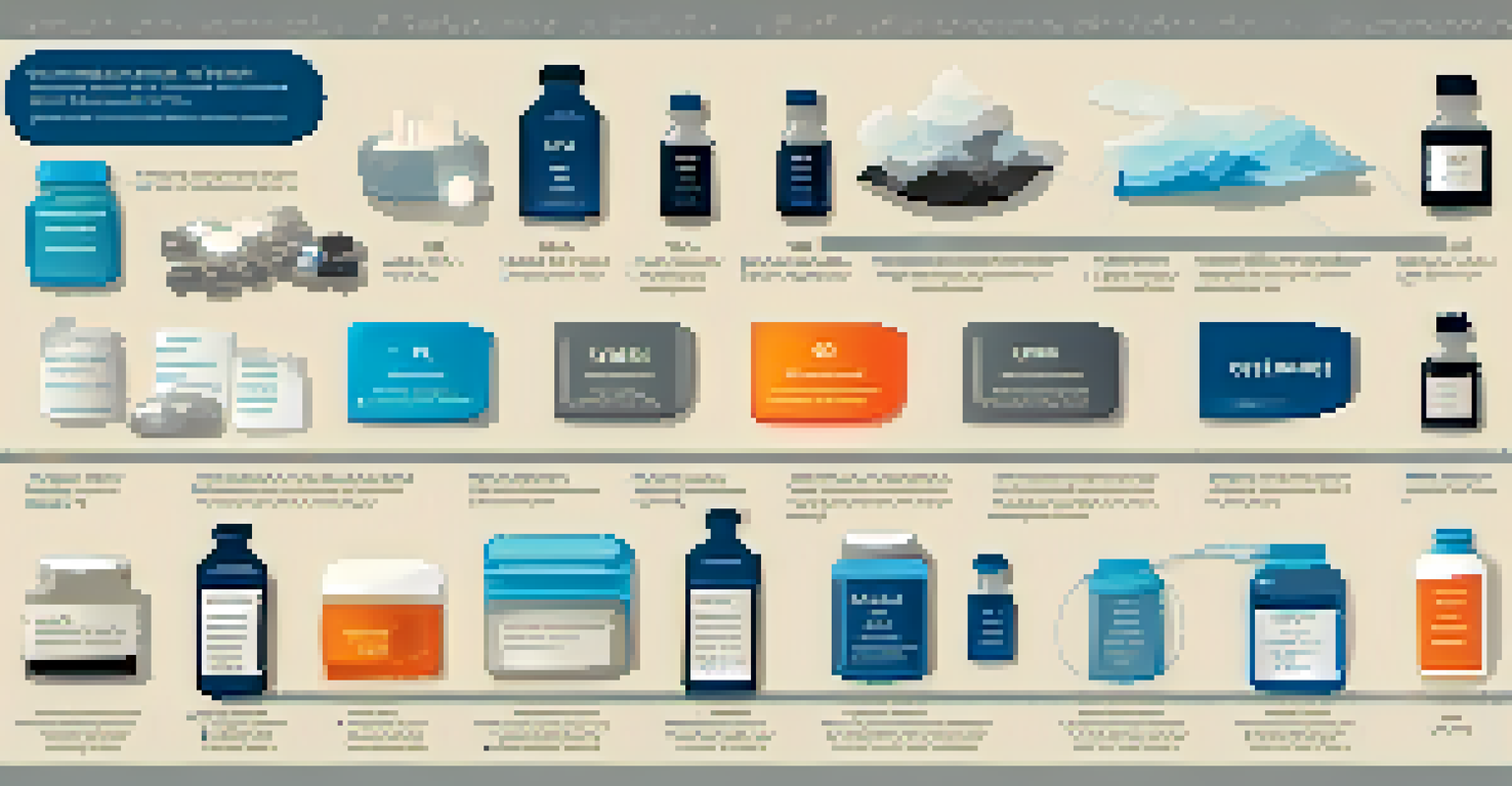Substance Use Disorder Classification and Legal Implications

Defining Substance Use Disorder: An Overview
Substance Use Disorder (SUD) is characterized by an individual's inability to stop using a substance despite its harmful effects. This can involve a wide range of substances, including alcohol, illicit drugs, and prescription medications. Understanding SUD is crucial as it affects millions of individuals and their families, leading to significant health and social consequences.
Addiction is a disease, not a moral failing.
The classification of SUD is primarily based on diagnostic criteria outlined in the Diagnostic and Statistical Manual of Mental Disorders (DSM-5). This manual provides guidelines for healthcare professionals to diagnose SUD, emphasizing the severity of the disorder based on the number of criteria met. These criteria include aspects such as tolerance, withdrawal symptoms, and the inability to fulfill major obligations.
Recognizing the signs and symptoms of SUD is important for early intervention and treatment. It's not just a matter of substance use but rather a complex interplay of psychological, social, and biological factors. By identifying SUD early, individuals can receive the help they need, paving the way for recovery and healthier lifestyles.
The Spectrum of Substance Use Disorders
Substance Use Disorders exist along a spectrum ranging from mild to severe, which helps to tailor treatment approaches. Mild SUD may involve occasional substance use that leads to some negative consequences, whereas severe SUD can encompass a complete loss of control over substance consumption. This spectrum is vital for understanding how different individuals experience and manage their substance use.

For example, someone with a mild disorder may still maintain their responsibilities at work and home, while a person with a severe disorder may face significant life disruptions, including health issues and legal problems. This classification allows healthcare providers to gauge the appropriate level of intervention needed. It's also important for loved ones to understand this spectrum to provide the right support.
Understanding Substance Use Disorder
Substance Use Disorder (SUD) is a complex condition characterized by an individual's inability to stop using substances despite negative consequences.
The differentiation of SUD severity not only aids in treatment but also informs legal implications. For instance, individuals with severe SUD may require more intensive legal and social support services compared to those with milder forms. This nuanced understanding can help change the narrative around substance use, emphasizing that it's a health issue rather than merely a legal one.
Legal Classifications of Substances
In the realm of law, substances are often classified based on their potential for abuse and medical use. The Controlled Substances Act (CSA) categorizes drugs into schedules ranging from I to V, with Schedule I drugs being deemed the most dangerous and without accepted medical use. This classification system is crucial for law enforcement and policymakers as it dictates regulations surrounding substance distribution and use.
The opposite of addiction is not sobriety. The opposite of addiction is connection.
For example, Schedule I includes substances like heroin and LSD, which are considered to have a high potential for abuse and no accepted medical use. In contrast, substances in Schedule II, such as oxycodone, can be prescribed but come with strict regulations due to their abuse potential. Understanding these classifications helps individuals navigate legal risks associated with substance use.
These legal classifications not only impact individuals who use these substances but also influence broader societal views on drug policy and rehabilitation. As conversations around drug decriminalization and harm reduction grow, the legal landscape continues to evolve, reflecting changing perceptions about addiction and treatment.
Impact of Substance Use Disorder on Legal Responsibility
One of the complex issues surrounding SUD is how it affects an individual's legal responsibility. In many cases, individuals with SUD may engage in illegal activities, such as drug possession or theft, driven by their addiction. Courts often grapple with the question of whether addiction should be considered a mitigating factor in legal judgments, influencing sentencing and rehabilitation options.
For instance, drug courts have emerged as alternative legal pathways for individuals with substance use disorders. These courts focus on treatment rather than punishment, allowing individuals to address their addiction while fulfilling legal obligations. This approach highlights the growing recognition that SUD is not just a criminal issue but a public health concern that requires comprehensive solutions.
Legal Implications of SUD
The relationship between Substance Use Disorder and legal responsibility is intricate, prompting discussions around treatment-focused alternatives like drug courts.
The legal implications of SUD extend beyond individual cases as they shape public policy and funding for treatment programs. Advocates argue for more compassionate approaches that prioritize rehabilitation over incarceration. By understanding the interplay between SUD and legal responsibility, we can work towards more effective solutions that support recovery and reduce recidivism.
Employment Challenges and Substance Use Disorder
Substance Use Disorder can significantly affect an individual's employment opportunities and workplace dynamics. Many employers conduct drug testing as part of their hiring process, which can disadvantage those with a history of substance use. The stigma associated with SUD often leads to discrimination, making it challenging for individuals in recovery to find stable employment.
Moreover, once employed, individuals with SUD may face difficulties in maintaining their jobs, particularly if their condition impacts their performance. This can create a cycle of unemployment and substance use, further complicating recovery efforts. Employers who understand SUD can contribute to a healthier workplace by offering support and resources for employees struggling with addiction.
By fostering a supportive work environment, employers can help mitigate the negative impacts of SUD. For example, providing access to Employee Assistance Programs (EAPs) can encourage employees to seek help without fear of stigma. Ultimately, addressing these employment challenges requires a collective effort to reshape workplace culture and support individuals' recovery journeys.
Legal Rights of Individuals with Substance Use Disorder
Individuals with Substance Use Disorder possess specific legal rights that protect them from discrimination. The Americans with Disabilities Act (ADA) provides certain protections for individuals in recovery, ensuring they cannot be discriminated against based on their history of substance use. This legal framework is vital for promoting equitable treatment in various aspects of life, including employment, housing, and access to healthcare.
However, it's essential to understand that these protections may not extend to individuals currently using illegal substances. The ADA typically protects those who are in recovery or who have completed a treatment program. Navigating these legal rights can be complex, and individuals may benefit from legal counsel to understand their protections fully.
Employment Challenges with SUD
Individuals with Substance Use Disorder often face significant employment challenges due to stigma and discrimination, impacting their recovery journey.
Raising awareness about these legal rights is crucial for combating stigma and promoting fair treatment of individuals with SUD. Advocacy groups play a significant role in educating both individuals and employers about these protections, helping to foster an environment where recovery is supported rather than penalized.
The Future of Substance Use Disorder Treatment and Policy
The landscape of Substance Use Disorder treatment and policy is rapidly evolving, reflecting a growing understanding of addiction as a complex health issue. Recent trends indicate a shift towards more holistic and integrative treatment approaches, combining medical, psychological, and social support. This comprehensive perspective is essential for addressing the needs of individuals with SUD effectively.
Moreover, there is an increasing push for policy changes that promote harm reduction strategies, such as needle exchange programs and safe consumption sites. These initiatives aim to reduce the negative consequences associated with substance use while encouraging individuals to seek help. As society continues to grapple with the opioid crisis and other substance-related issues, these innovative approaches are gaining traction.

Looking ahead, collaboration between healthcare providers, policymakers, and communities will be crucial in shaping effective treatment and prevention strategies. By prioritizing research, education, and supportive policies, we can work towards a future where individuals with Substance Use Disorder receive the compassionate care they need to thrive.